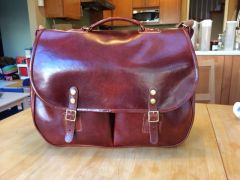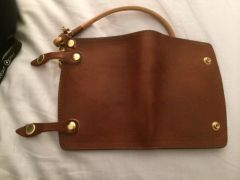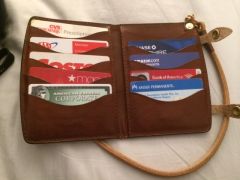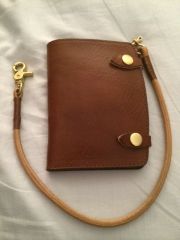-
Posts
719 -
Joined
-
Last visited
Content Type
Profiles
Forums
Events
Blogs
Gallery
Everything posted by Andrew Chee
-
From the album: Hunting Bag
-
For your unable to close problem, it doesn't look like a leather thickness issue. Assuming your leather is indeed 3oz, that thickness is just fine for a wallet. The ones that I have made are 3-6oz on the outside and the interior pieces are about 2oz. The problem looks like you're making the external panel the same size as your internal panel. You have to make the external panel about 1/4-1/2" longer so that when it folds, things don't bind up. I'm not sure what Dwight is saying about needing multiple pieces on the inside. If you look at my wallet below, the inside is basically a single panel like yours. To make the outside panel larger, there are two ways to do it. You can just cut a piece that's longer. When you sew it, you will then have to leave a gap when you get to the spine of the wallet. The other way is like in the wallet below, you cut the outer piece in a trapezoid shape so the open end of the panel is slightly longer but the closed end is the same length as the wallet. I hope that helps in thinking about the design. Good job on trying to come up with your own design. Andrew
-
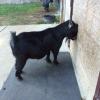
Mid-Length Wallet
Andrew Chee replied to Andrew Chee's topic in Purses, Wallets, Belts and Miscellaneous Pocket Items
The seam in the middle was cause I didn't have a splitter wide enough to split the entire piece. I don't think it would wear as well with the seam down the middle... Andrew -

Bag Construction On A Cylinder Walking Foot
Andrew Chee replied to Flattracker's topic in How Do I Do That?
Basically sewing machines may/will leave marks on the leather. The walking foot may leave tracks on the top. I usually have less of an issue with the feed dog leave tracks cause my feed dog are smooth. Whether they leave tracks also depends on the type of leather. Not just veg tan vs. chrome tan. If I use W&C skirting leather, I don't really see much in terms of tracks. If I use W&C harness leather, the tracks are more apparent. This is probably due to the wax content in the leather. These tracks can by minimized by controlling the foot pressure but in many cases, you may not be able to eliminate them. It's just a matter of a small metal foot pressing on the leather that causes the tracks. Some people use roller foot machine to help minimize tracks. I've still seen leather goods where you see the tracks. Probably the only way to ensure you never mark on any leather is to hand stitch. Andrew -

Mid-Length Wallet
Andrew Chee replied to Andrew Chee's topic in Purses, Wallets, Belts and Miscellaneous Pocket Items
Updated my gallery with the second rev of my wallet. This time I used hand boarded W&C harness leather. I got a wider splitter so no more seams in the middle. Left the outside piece at 5-6oz. Andrew -
From the album: Mid-length Wallet
-
From the album: Mid-length Wallet
-
From the album: Mid-length Wallet
-

When Is It Hand-Made, As Opposed To Machine-Made?
Andrew Chee replied to Ian1783's topic in Marketing and Advertising
I think what Nvleatherworx says is good. One thing that bothers me is when I see things that are termed "hand made" and the quality is not very good (the edging is poor or the stitches are not straight and even) and people try to explain it away by saying its hand made. My personal opinion is that it should be made better than what some factory in china can make them. Otherwise, why not buy it from the factory in china? It'll certainly be cheaper. Andrew -
Your backside looks about right for a lockstitch machine. The back is never going to look as nice as the front... Andrew
-
Can you take some pics to demonstrate your setup? Andrew
-
Hello all. I have a Pfaff 335 and a Consew 206RB. On each of these machines, the reverse is spring loaded so I have to hold on to the reverse lever when stitching reverse. I would like to have both hands free. Is there a reliable way to modify the reverse so that it either is not spring loaded (like a 441 clone) or use a pedal to set the reverse? Anyone done this? Thanks. Andrew
-
Are you interested in selling the Efka? Andrew
-
How much difference in thickness is there? I think it is an issue with blade based splitters that if you go through firmer or softer areas of the hide that there will be some variance in thickness. Unfortunately that has to do with the basic fact of blade splitters. But then again, it also depends on how much difference you're seeing. If more than +- 1/2oz or so there might be a problem. Andrew
-
Thanks for the part number. I tried to look it up in the Pfaff parts book but for some reason the part number for that particular item was blanked out... Andrew
-
-
Sold! Andrew
-
Does the leather always pull sides on one side? It could be that your lower roller is slightly higher on one side then the other. If that happens, more rolling pressure is placed on the leather on one side than the other causing it to turn. One way to check this is to get a feeler gauge and place it between the blade and the bottom roller. I'm not sure what the gap is set at but you can probably find the right thickness to test with. The feeler gauge should not feel looser on one end of the roller than the other. There should be uniform resistance throughout the entire length of the blade to bottom roller contact. Also, check the top roller to blade distance. It needs to be parallel as well. This should have been adjusted before Steve/Dave sent you the splitter but sometimes things happen... I just got an LMC splitter as well. I didn't have this problem with my splitter but I did have that problem with my old American 6 inch splitter until I learned how to adjust it. Andrew
-
I've seen that pic before definitely an impressive edge. I'm not sure bob park's method can achieve that look because his method uses saddle soap and friction heat that might darken the edges. The edge above does not look like the leather has darkened too much. I've wondered how this one was done and have no idea. Andrew
-

Great Latch But What's It Call And Were Do I Find It?
Andrew Chee replied to Shanna Spatz's topic in Hardware and Accessories
That is pretty cool. Where are the pictures from? Andrew -

Need Help With Wallet Construction..
Andrew Chee replied to balsammountainleather's topic in Leatherwork Conversation
Are the pieces from corter hand cut and punched or are they clicked from a die? If from a die then that's your answer. Of hand cut then he's just really good at cutting straight. Btw, from what I understand, pricking irons are meant to mark the stitch locations. The awl actuall does the punching through. At least traditionally that's how I've seen it done. Andrew -

Does Compound Feed Mean It Is A Triple Feed?
Andrew Chee replied to Flattracker's topic in Getting Started
All of those machines are compound/triple feed. They all have smooth feet and feed dogs either available or easily modified. The different feet can be purchased relatively inexpensively. The 335 is a very nice machine because it is a cylinder arm and has a synchronized binder. The Consew 206 machines are less expensive but are flat bed and don't have a synchronized binder. Neither are mark proof though. It's really an issue of the type of leather you use and the pressure setting on the machine. When I sew very firm veg tan leather, it will still leave tracks. When I say tracks I mean you can see that it was sewn by a machine but there are no teeth marks. You may be able to rub the tracks out afterwards but it will leave a little bit of a track. Andrew -
Part of the question is what aesthetic do you like? I personally prefer solid brass because there's no plating or coating to wear off. Solid brass nowadays usually has a clear coating put on the, so they don't oxidize as easily. This coating will probably wear out after years of use and there will be some patina on the brass. Plated brass means just that. Solid brass inside, chrome or nickel plating on the outside. Plating is usually pretty solid and should not wear off but who knows what might happen after years of use. The difference between nickel and chrome is probably more of an aesthetic choice. Stainless steel is probably the strongest of all the materials. I'm not sure if stainless can be plated so you might be limited to the color choice. Steel is just that, steel but not stainless. Usually it will be plated for aesthetics and rust resistance. Steel by itself will rust over time. Chrome or nickel plating will help prevent that and will look good. Steel is very strong as well. Zinc, cast zinc, and plated zinc is usually the cheaper stuff. Zinc is an inexpensive material. Not as strong as the other two above. When plated you may not be able to tell the difference unless you held them and felt the weight. This is usually what the cheap hardware is made of. Thighs that just say "plated" usually mean nickel of chrome plating over zinc. I've heard of plated plastic but I would assume no one uses those for leatherwork. Andrew
- 6 replies
-
- hardware
- stainless steel hardware
-
(and 3 more)
Tagged with:
-

Does Compound Feed Mean It Is A Triple Feed?
Andrew Chee replied to Flattracker's topic in Getting Started
Depending on the machine and what parts are available for them, smooth feed dogs and presser feet may be available. It just depends on what people sell. If not, you can always take an existing feed dog or foot and grind down the teeth to smooth or almost smooth. That's what a lot of the dealers around here would do if a smooth version of a part is not made. Depending on the machine, these parts can be very cheap (like for singer 111) class type machines so it won't cost you too much to do this. Andrew -

Does Compound Feed Mean It Is A Triple Feed?
Andrew Chee replied to Flattracker's topic in Getting Started
Compound feed and triple feed basically mean the same thing. There are compound feed machines designed more for fabric and ones more for leather. The basic difference is that the ones for fabric will have teeth in the feed dogs and feet and the ones for leather will have smooth ones. Teeth help the feet grab fabric better where leaving marks is not a concern. A compound feed with smooth feed and feed dog is what you're looking for. Bear in kind though that these machines may still mark some because they are putting pressure on the leather (pressing against it) but the marking would be much much less and it may be possible to adjust the presser feet pressure to minimize marking. Andrew



